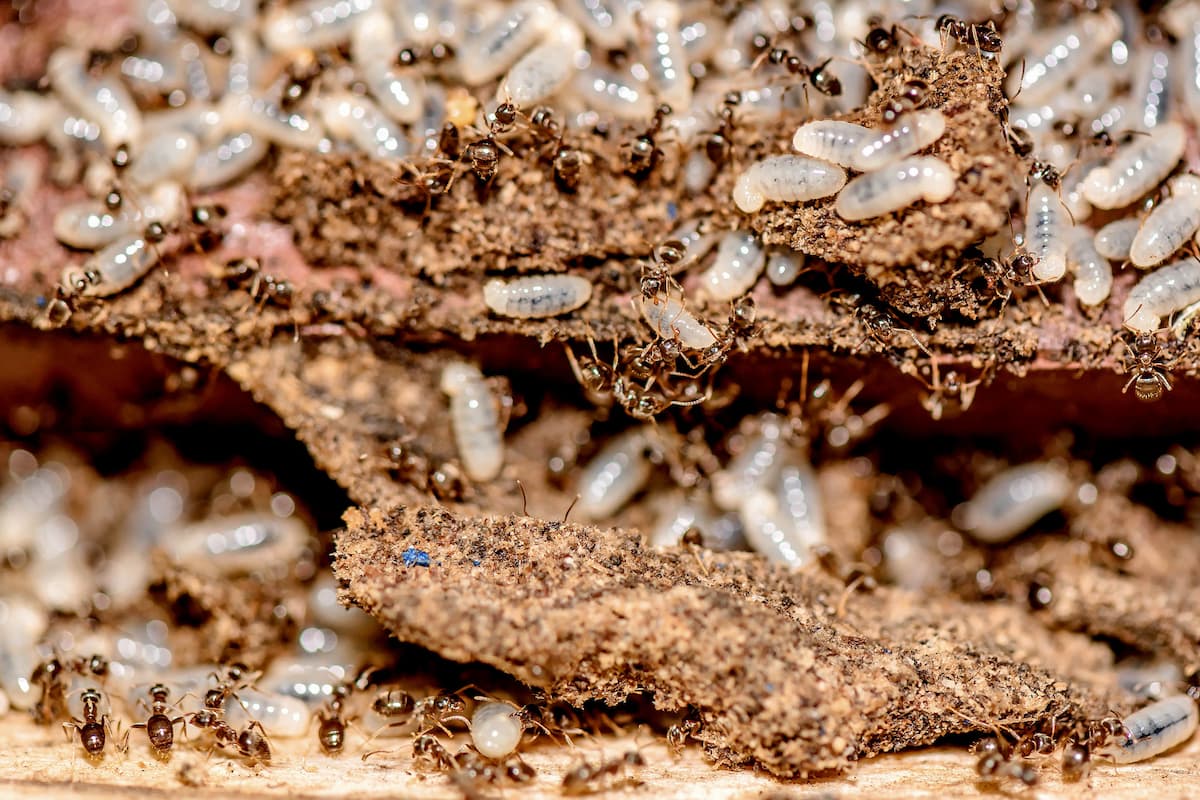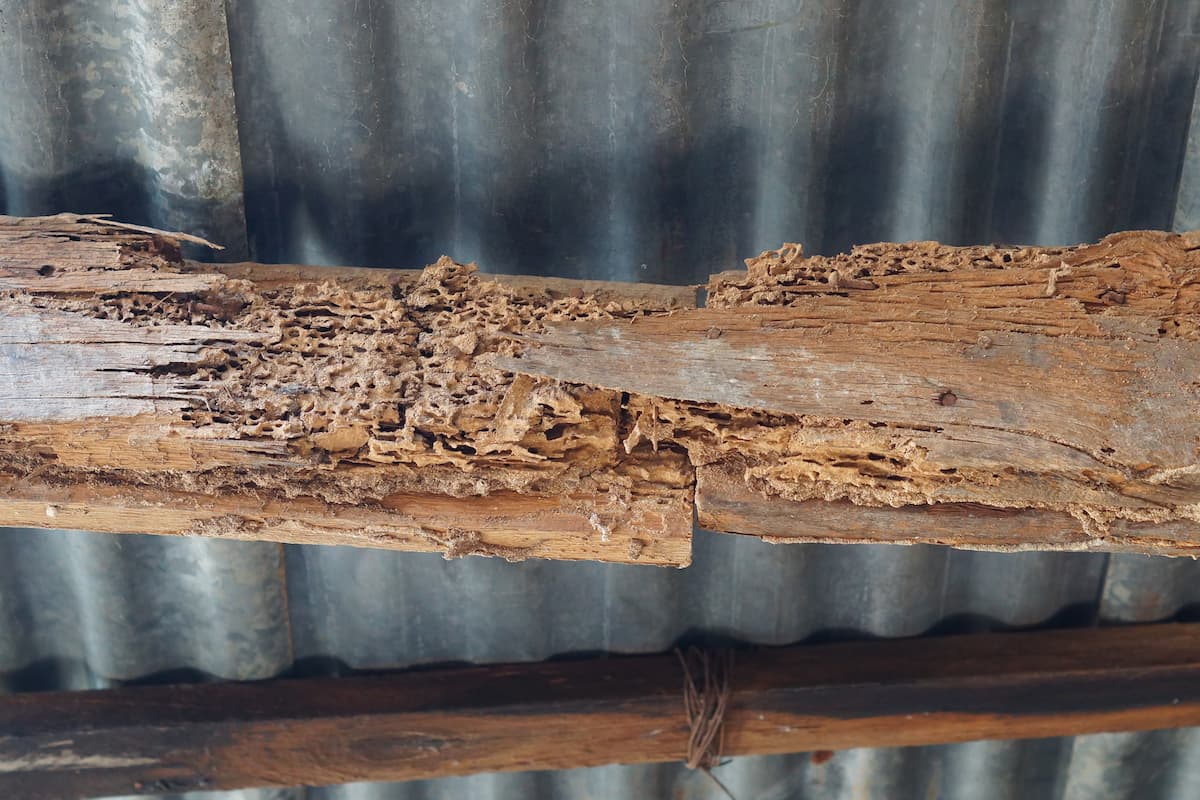Do Termites Stay In One Area?
If you have termites in your home, you may be hoping they remain in a single spot so that they don’t damage other places.
Termites do not stay in one area. Since termites must forage for food to survive, they remain on the move. Also, swarmer termites go off to start their own colony, which they may also begin in or near your home.
Why Don’t Termites Stay in One Spot?

Termites don’t stay in one spot because they always need to make sure they have enough food for the colony to survive.
And if the colony is large, they will need a lot of food.
Thus, if there are termites in your home, they are going to be constantly searching for more potential food sources.
How Far Will a Termite Colony Spread?
Overall, the colony doesn’t really go too far from its queen.
You see, the queen of a termite colony is too large to walk and must stay in one spot.
And the termite colony needs to protect its queen because she is the primary reproducer, and without her, the colony can’t grow.
So, usually, a termite colony won’t go further than 100 feet in any direction from its queen.
But, if the termite colony requires food, it may venture farther away.
Therefore, the nest, and colony, don’t actually move.
It is just that the termites might journey pretty far from the nest to look for food.
How Do Termites Create New Colonies?

Since termites have to stay near their nest, they only truly spread when a new colony forms.
And these new colonies are always started by swarmer termites.
These winged termites leave their nests, usually in the spring, to find a mate and a location for a new nest.
Once they’ve located these two things, they shed their wings and begin to mate so that they can form a colony of their own.
Unfortunately, though, this new colony may not be too far from the old one, meaning you could have more than one colony in or near your home.
Do Termites Reproduce Quickly?
Termites can reproduce quickly.
How fast they reproduce depends mainly on the age of the colony.
A new queen can typically only lay up to 12 or so eggs a week.
Yet, after some time, she may be able to lay more than 1,000 in a day.
Gradually, all this reproducing can equal one million termites in a single colony.
A colony of this size can do extensive damage to property within a year or two.
How Do I Know if Termites Have Spread?

Unfortunately, it isn’t easy to tell if termites have spread to other areas of your home.
Termites typically like to stay in hiding, so it is doubtful you will see them moving around.
But, there are a couple of methods that can help you determine whether a colony has migrated to other areas of your home.
New Termite Damage
Of course, if you begin to spot new termite damage in parts of your home that termites hadn’t previously affected, the termites may have spread.
You should be aware, though, that termite damage doesn’t just appear as chew marks on wood.
Other signs of termite damage that you’ll want to look out for include:
- Tiny holes in drywall
- Drooping paint
- Peeling paint
- Wood that sounds hollow when you tap on it
- Floors that sag or feel weak when you step on them
- Squeaky floorboards
So, if you have termites, you should search your house periodically to see if you notice damage in new areas.
New Mud Tunnels
Not all termite species make mud tunnels.
However, subterranean termites do, and they are some of the most common termites in the United States.
And, by using these tunnels, subterranean termites kind of tell on themselves.
You see, these termites create mud tubes to get around because the shelter protects them from predators and helps their bodies retain moisture.
So, if you see their tunnels, you will know exactly where they are going and where they’ve been.
Therefore, if you see mud tunnels leading toward areas of your house that don’t yet show signs of termite damage, you will know that the termites have spread.
Termite Droppings
Another way you can figure out where termites have been is through the location of their droppings.
Drywood termites leave piles of feces, called frass, wherever they go.
So, if you see these droppings, which either look like sand or coffee grounds depending on the species, you’ll know exactly where the termites have been.
Subterranean and dampwood termites, though, don’t normally leave feces marks, so you probably won’t be able to tell where these termites are according to their excrement.
Can Termites Spread Through Clothing?
You may have heard that certain insects, such as bed bugs, can spread to new places on people’s clothes, which may lead you to wonder if termites can do the same.
Well, although termites can sometimes infest and eat clothes, they do not nest in them.
Therefore, it is unlikely that a reproducing termite will be on your clothes.
Can Termites Spread Through Furniture?

Yes, termites can spread through furniture.
Certain termites, most notably the drywood variety, can nest in furniture.
Thus, if you take home an infested piece of furniture, you could possibly be bringing an entire termite colony into your home.
And having an entire colony in your house means that there will be reproducers who can keep the colony thriving.
Therefore, if you are considering bringing home a piece of used furniture, you should inspect it for termites first.
The signs of termites in furniture include:
- The actual insects
- Damage, such as chipped wood or holes
- A hollow sound when tapped
- Sawdust
- Termite droppings
- Mud tunnels
If you see any of these indications in a piece of furniture, do not bring it home.
The furniture is not worth the risk of getting a termite infestation.
Will Termites Stay in the Wall?
Many people who have termites worry that the insects will come out of the wall and infest other items in their homes.
But will termites actually do this?
Typically, termites will stay in the wall.
If you have a wood frame home, the termites will have plenty to eat and won’t need to come out to look for food.
Additionally, termites like to remain in secluded places to keep themselves safe from predators.
However, there is technically nothing stopping termites from coming out of the walls.
And termites can actually consume other items in your home, such as fabric, carpet, and plants.
Therefore, you could possibly see termites venture out of your walls and floors to snack on other items.
How Fast Does it Take Termites to Destroy an Entire House?

How quickly it takes termites to destroy a house depends on the colony’s size.
It also depends on what is meant by “destroyed.”
If you mean how long it takes for termites to cause significant damage to a home, I can say that it typically takes anywhere from 1-10 years.
Yet, if you want to know how long it will be before the termites eat your entire house, it would most likely take more than a decade.
Conclusion
While a termite nest normally stays in one area because the queen can’t move, termites can venture rather far in search of a meal.
Table of Contents
- Why Don’t Termites Stay in One Spot?
- How Far Will a Termite Colony Spread?
- How Do Termites Create New Colonies?
- Do Termites Reproduce Quickly?
- How Do I Know if Termites Have Spread?
- Can Termites Spread Through Clothing?
- Can Termites Spread Through Furniture?
- Will Termites Stay in the Wall?
- How Fast Does it Take Termites to Destroy an Entire House?
- Conclusion
